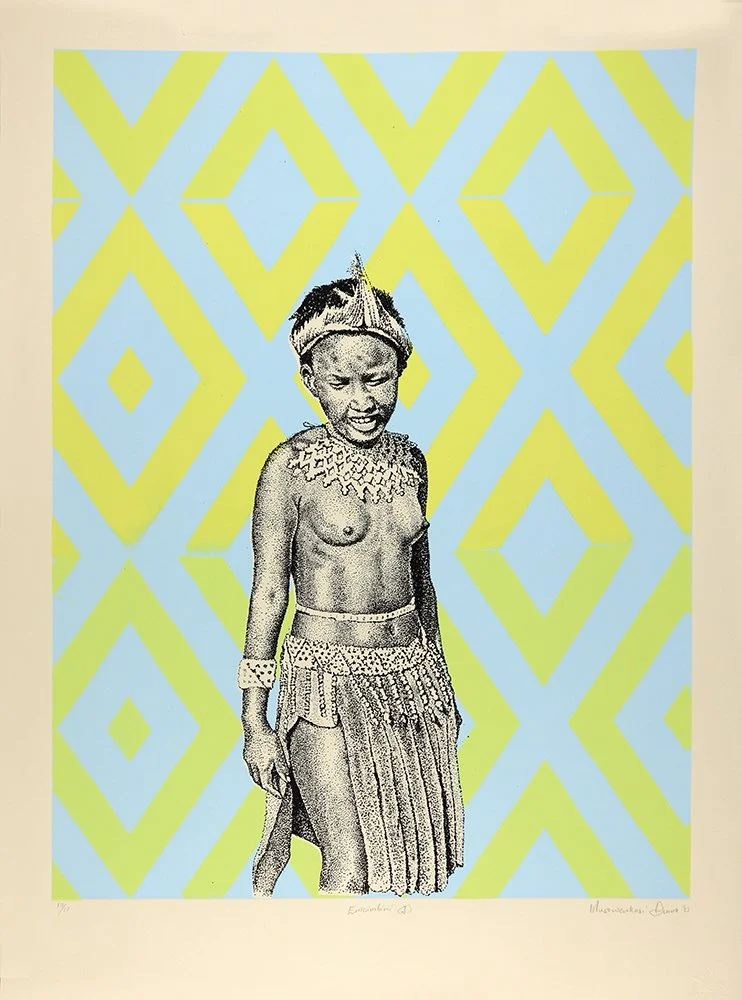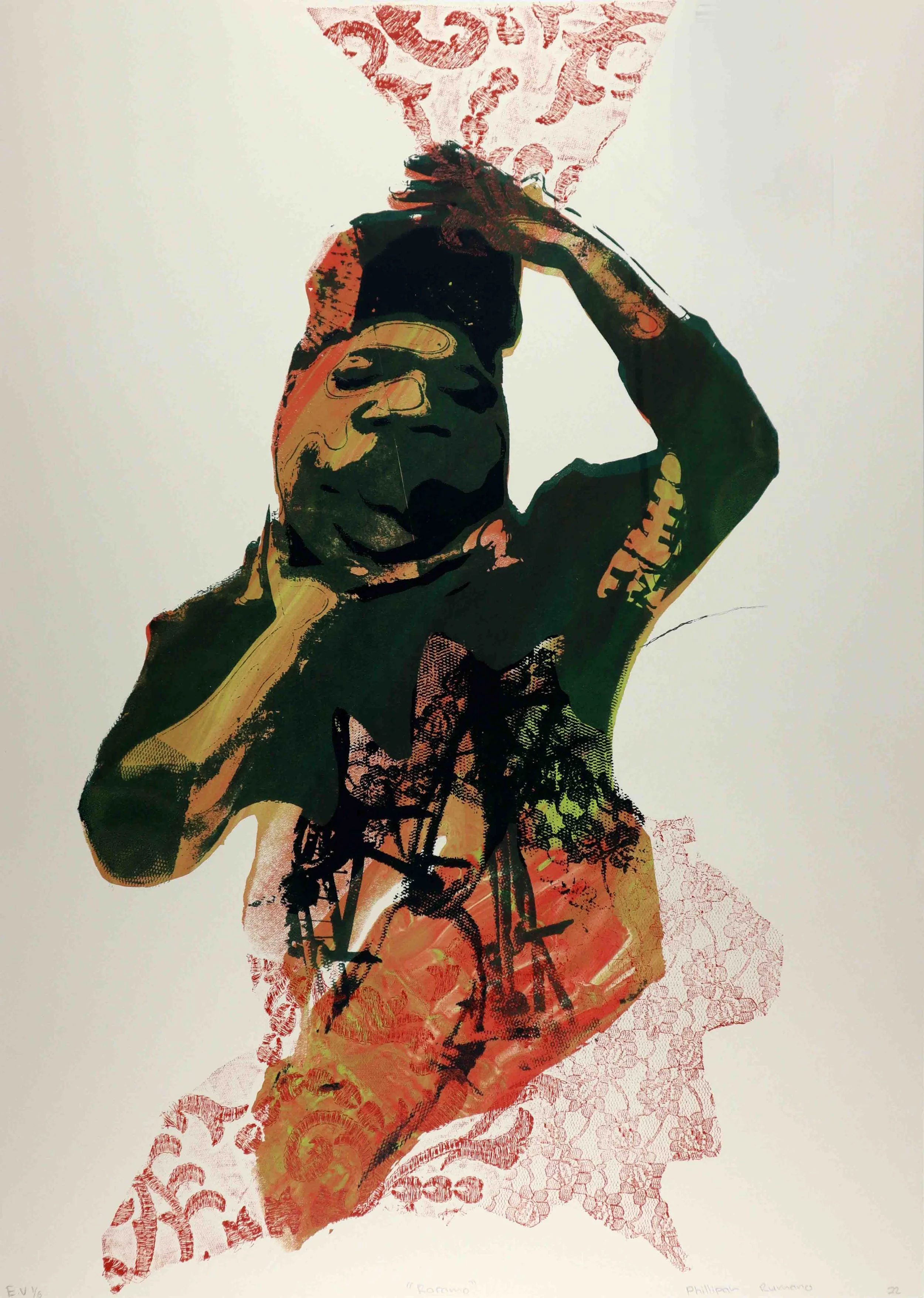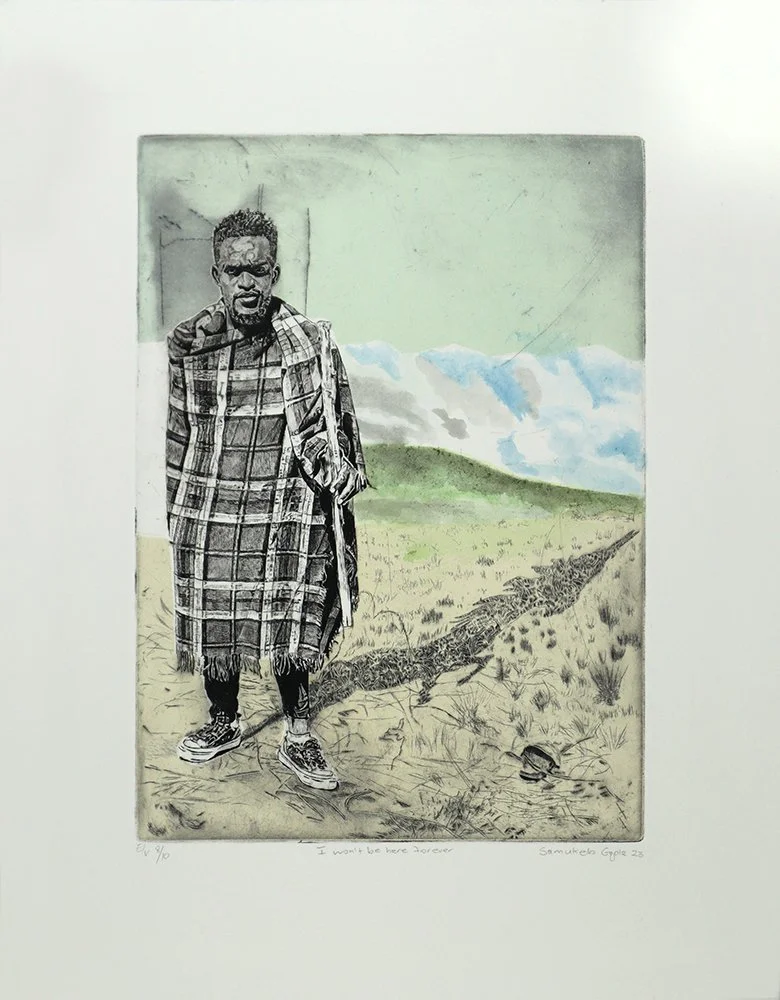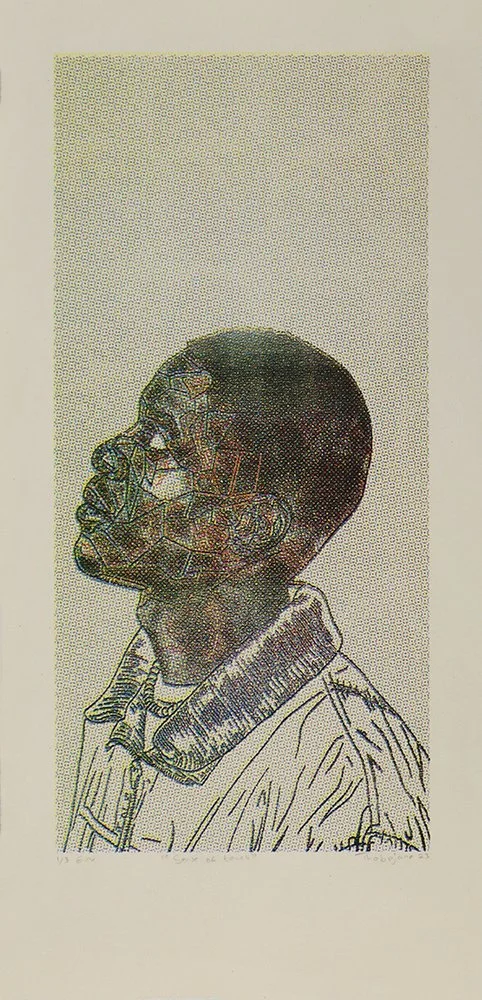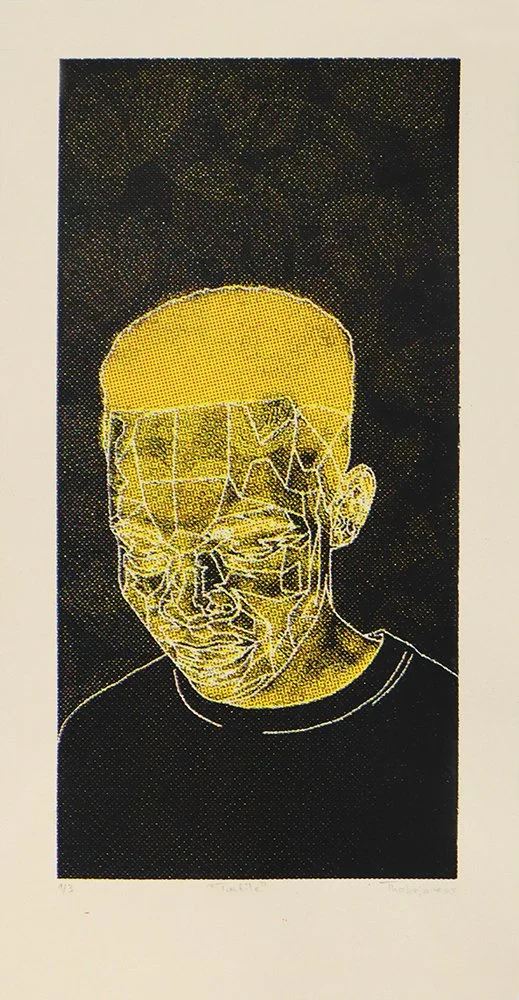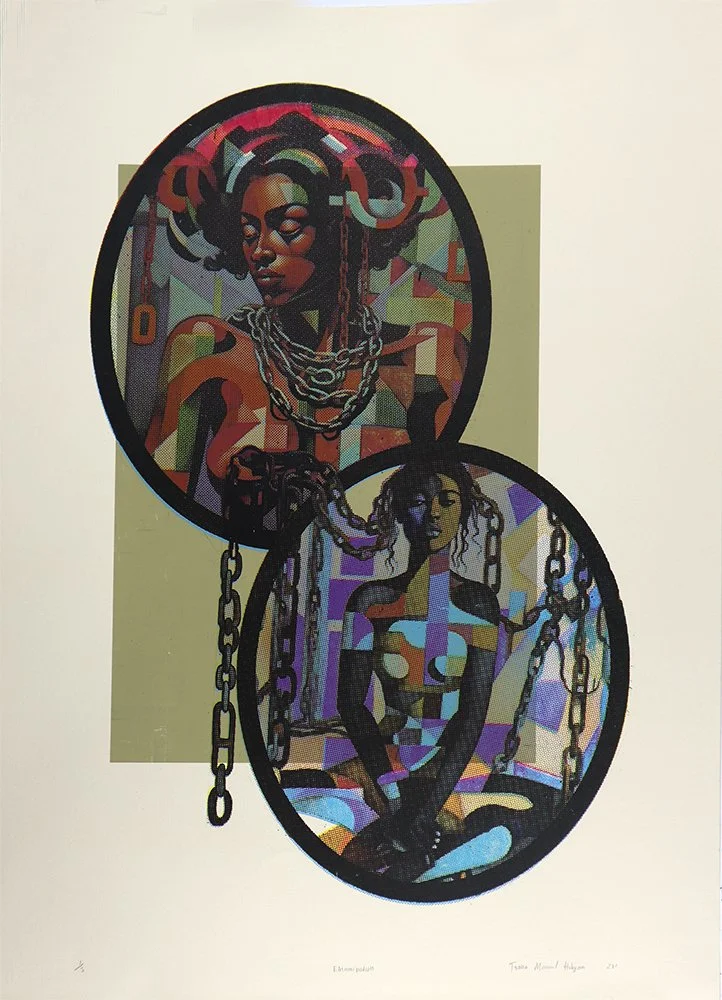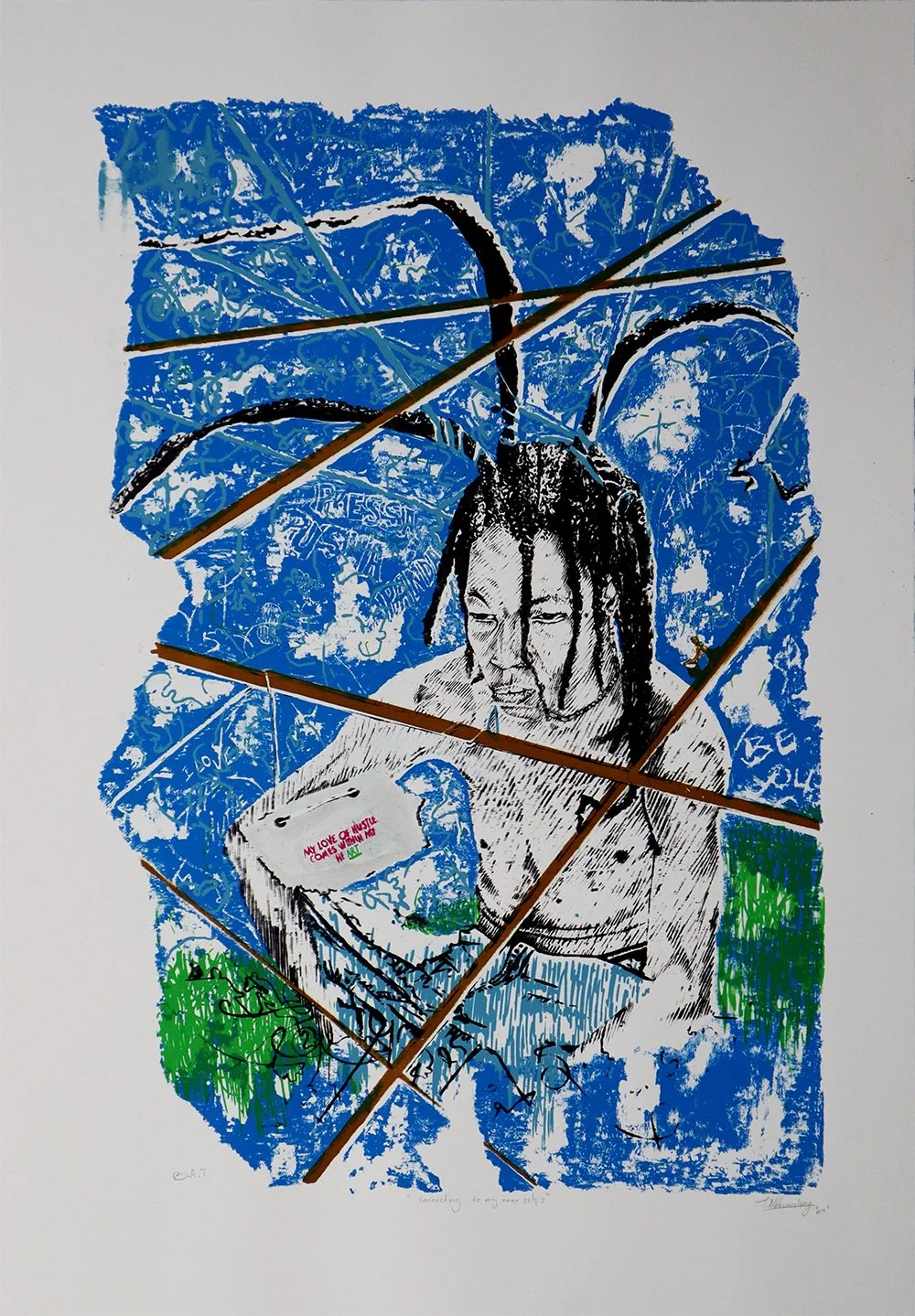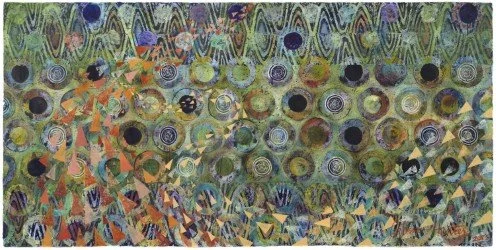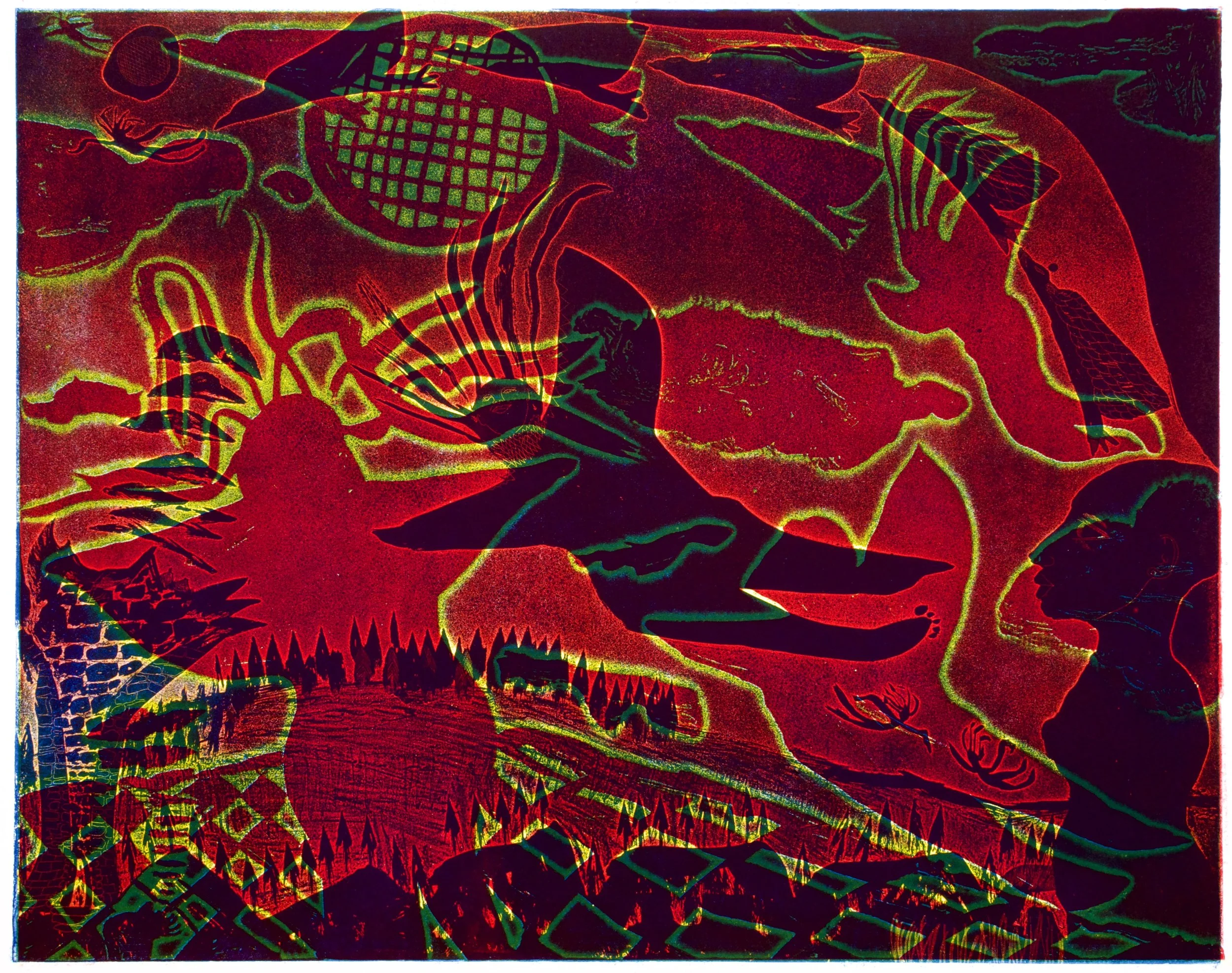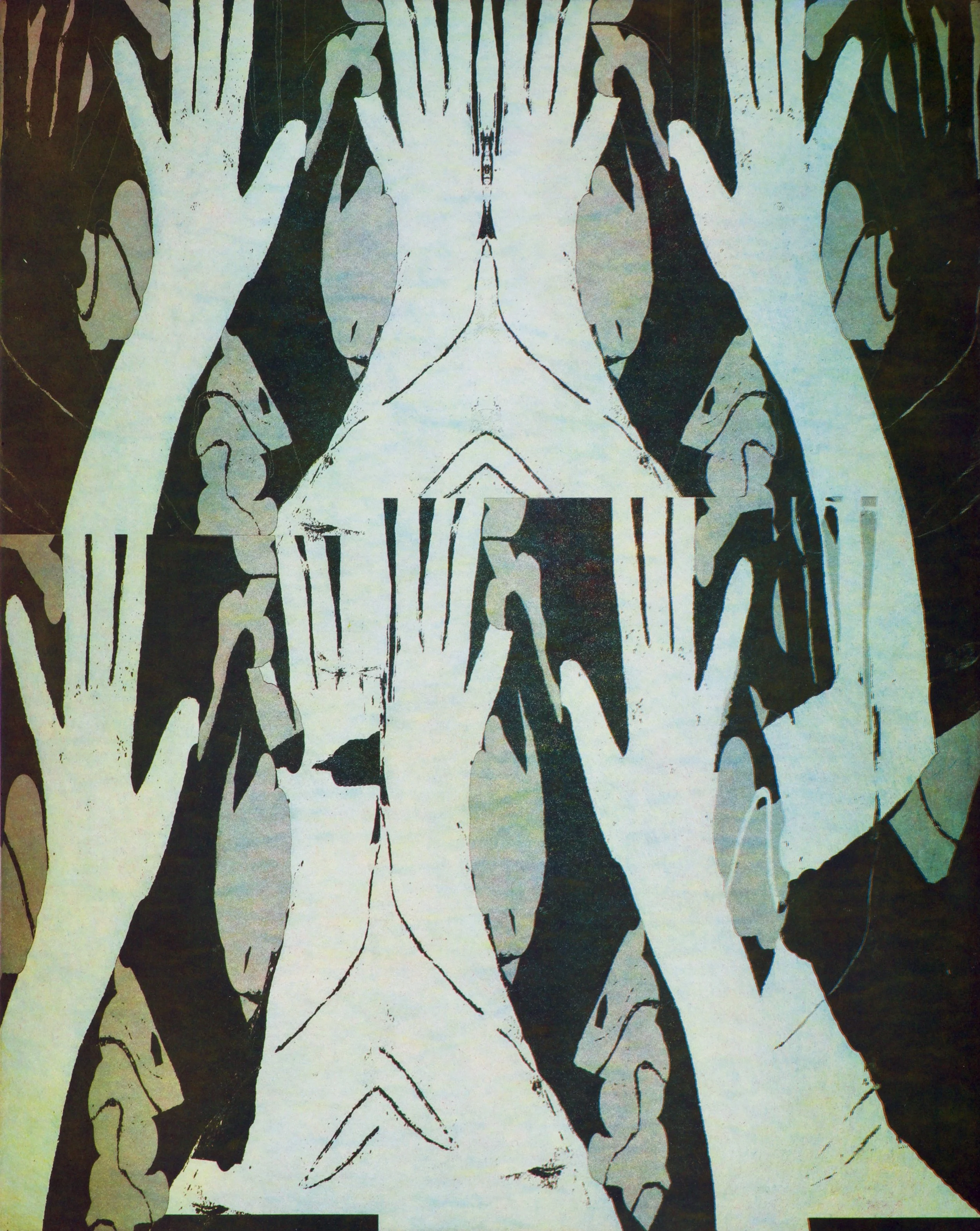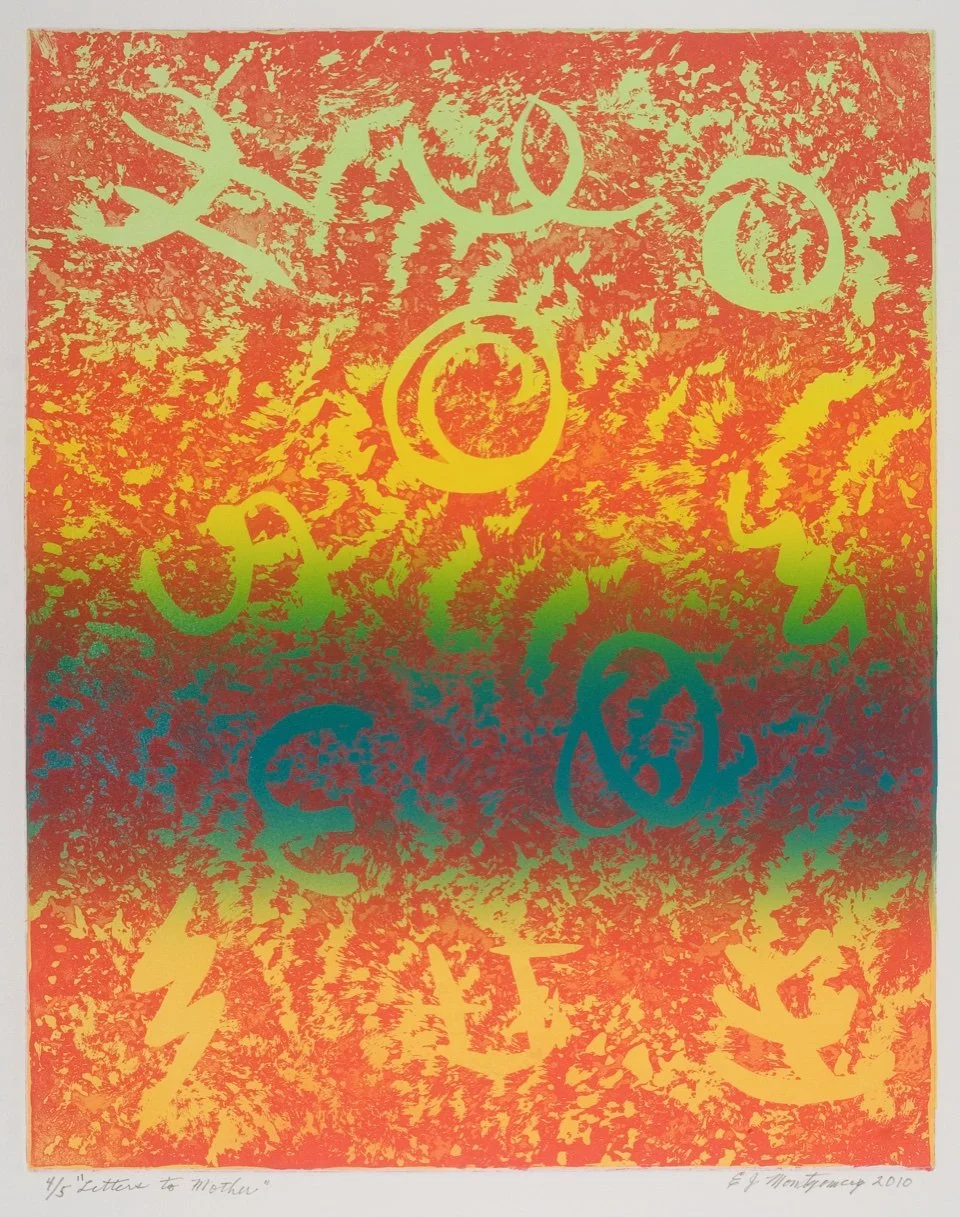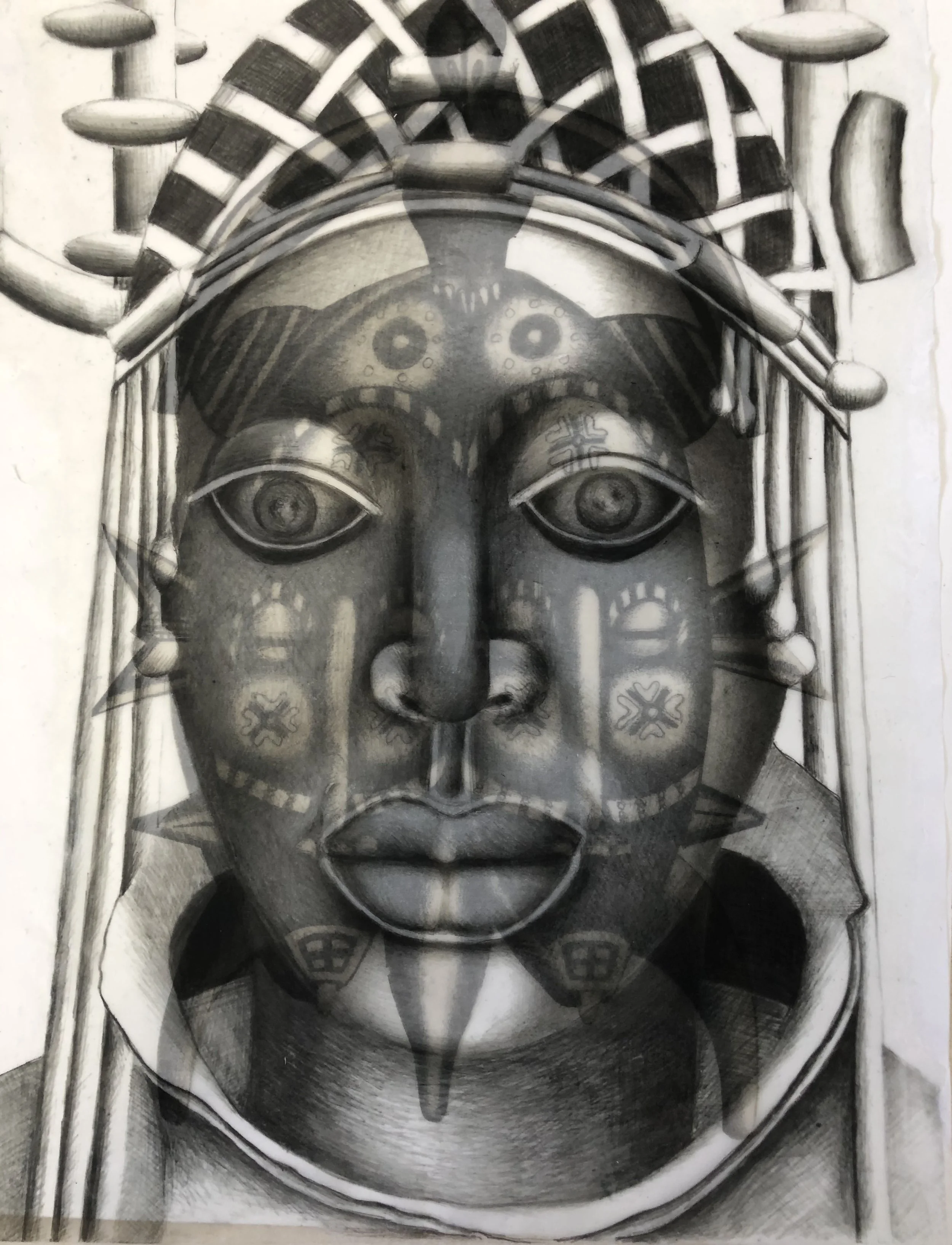FACES & FIGURES: IDENTITY THROUGH PRINTMAKING BETWEEN DC AND SOUTH AFRICA
/FACES & FIGURES:
IDENTITY THROUGH PRINTMAKING
BETWEEN DC AND SOUTH AFRICA
September 13 - December 6, 2024
Mason Exhibitions Arlington
About the Exhibition
Faces & Figures: Identity Through Printmaking Between South Africa and D.C. explores artists’ expressions of identity in South Africa through the lens of printmaking. The exhibition features works of alumni and current artists of the Artist Proof Studio (APS), based in Johannesburg, South Africa. Featuring over 100 prints by 26 artists, the prints range in technique, style, and subject matter, drawing inspiration from South African popular culture and history as well as personal narratives.
The exhibited works explore aspects of South Africa’s history and the struggle for equality following the end of apartheid, a racist and oppressive political system in which the white minority ruled over the Black majority from 1948 to 1994. The works on display demonstrate the artists reconciling persistent challenges, including poverty, inequality, and crime, while celebrating their home city and South African heritage. At the heart of this reconciliation lies their dedication to Ubuntu.
Often translated as “I am because we are,” Ubuntu philosophy is the embodiment of interconnectedness, communal solidarity, and collective well-being. Community extends beyond immediate family ties, encompassing broader social networks and fostering a spirit of inclusivity and mutual support. Post-apartheid South Africa has experienced a resurgence of interest in Ubuntu as the foundation for rebuilding identity and societal structures after colonial ideologies challenged the foundational spirit.
Featured Artists: Bambo Sibiya · Bekithemba Mdluli · Bokang Mankoe · David Madlabane · Donald Makola · Hlavutelo Ngobeni · Hlelowenkosi Molefe · Joel Mpah Dooh · Chevy Noir · Khumo Ramaila · Lindo Zwane · Lucas Nkgweng · Mandlenkosi Mavengere · Misa Boshoma · Musawenkosi Duma · Nkosana Nhlapo · Phillipah Rumano · Samukelo Gqola · Sekedi Sekgobela · Seza Zitha · Sifiso Temba · Thabo Skhosana · Thato Thobejane · Thulani Gankca · Tsako Hobyani · Tshogofatso Nkhumeleng
Bridging the diasporic community of Black printmakers, the exhibition expands to include DC-based printmakers EJ Montgomery, Gail Shaw-Clemons, Aziza Claudia Gibson Hunter, Michael B. Platt, and Percy Martin.
INSTALLATION VIEWS COMING SOON
Participating Artists and Artworks
Street Barber II
Bambo Sibiya, was born in KwaThema, Springs, near Johannesburg. Following his completion of a Design certificate at Benoni Technical College in 2006, Sibiya’s teacher, Paul Madi Phala, recommended that he should apply to Artist Proof Studio (APS) to train in printmaking, where he has also worked on large scale linocuts for several leading artists, including William Kentridge, Diane Victor, Norman Catherine and Colbert Mashile. He has performed extremely well in South African art competitions in recent years: in 2012, he was a finalist in the ABSA L’Atelier top ten awards, and the winner of the prestigious Gerard Sekoto Award, which facilitated his completion of two residencies in 2013 at Atelier le Grand Village (Angouleme, France), and at Cité Internationale es Arts (Paris, France). Bambo’s works are held in the Bibliothèque Nationale de France (the national collection of prints), amongst others. Sibiya draws on traditional printmaking techniques centered around the spirit of Ubuntu Ngabantu, a term deriving from Zulu philosophy and translating roughly into “I am what I am because of how we all are”.
Bekithemba Mdluli, better known as Themba, was born in 2001, Boksburg, South Africa. Mdluli is a painter, printmaker, and digital artist based in Johannesburg. He is currently completing his 3rd year at the Artist Proof Studio specializing in linocut and etching print techniques. The aesthetic style of his prints are inspired by Manga and comic book illustrations. The medium of linocut reminds him of how characters are illustrated in comic books. His work is inspired by the surreal events that have happened in his life, from the eyes of a boy who grew up in a religious household. Through his retellings and reinterpretations of biblical stories, Mdluli imagines people as symbols of angels representing concepts of love, death, and his past. The angels are shown with long necks, wearing motorcycle helmets as armour, existing not to interact with anyone but only to protect the gods. They rank above the hands of God, which are black figures that travel around to watch over and interact with people bringing about their end when they stray too far from the path of destiny.
One Point Word
Bokang Mankoe, was born in 1992 in Tembisa, Johannesburg. He pursued his passion for printmaking at Artist Proof Studio, joining in 2013, where he honed his artistic skills and creativity. Following his graduation from APS, Bokang worked as an assistant printmaker for the renowned William Kentridge Horses series, contributing to the creation of Marcus Aurelius, Garibaldi, the Triumph of Bacchus, the Skeleton Horse, and Refugees prints. Taking his art beyond borders, Bokang was featured in a group show curated by Zea Mays Printmaking, held in Boston, MA, USA, in 2019 and various online shows. Currently, Mankoe serves as the Coordinator at the Professional Printing Workshop in APS, managing printing projects for fellow professional artists since 2022. His dedication and passion for art continue to drive his exploration of the concept of the "Perfect Man" and the exploration of masculinity in contemporary society. The passing of his father led him on a journey of introspection, seeking to understand and define what the ideal male figure would be for his younger brothers and sisters. Drawing inspiration from Leonardo da Vinci's depiction of the Golden Ratio face, characterized by its geometric lines, Mankoe utilizes his profile as a canvas to create an alter-ego, representing the unattainable perfection that exists in another dimension beyond reality. This concept finds expression through his multi-layered monotypes and linocut reductions. Mankoe deliberately uses unwanted paper and creates handmade paper, symbolizing the cycle of life.
David Madlabane, is a visual artist based in Johannesburg, specializing in a wide range of mediums such as drawing in ink, charcoal, painting, digital art and producing music. He also specializes in printmaking techniques such as linocut, silkscreen, and etching to name a few, and has been an assistant at Artist Proof Studio and at William Kentridge’s studio. The body of work exhibited by Madlabane deals with the human experience - where loss can evoke so much pain to the point where one feels as if they are in darkness. He explores the devastation of that period that can cause one to breakdown and question everything from their existence to the most high. During this period, the feelings of being anxious and out of place and surface which can lead to feeling incomplete and broken. The process of trying to piece themselves together can be a hard task with different emotions and crippling thoughts taking over their mental state, leading them to start behaving differently and shifting their perspective on life.
Donald Makola, was born in December 1985 in Limpopo Province, the northernmost province in South Africa. He grew up in rural Limpopo and moved to Johannesburg to continue his studies and in 2009, he joined the Artist Proof Studio. The subject of Makola’s work is family. In this body of work, he is specifically looking at his father’s family and the presence of the father figure as head of the family. In his images, Makola uses objects and tools as metaphors to describe the hard work and encouragement his father provided his family. Most of the objects and tools chosen are used in the home – specifically the yard. He often places the subject on gravel road or pavements. The gravel represents the rural area and the pavements the urban environment. He specializes in intaglio techniques, providing him with variations in textures and tones. He also uses intaglio etching to provoke the idea of memory. His images are inspired by Gerard Sekoto, particularly the image titled; ‘Proud Father’. Makola’s work is a tribute to his parents. He hopes that it is inspirational to fathers to be loving and responsible. He aims to not forget how he was raised and the love he grew up in.
Forefathers
Hlavutelo Ngobeni, born in 1998 in Thomo village, Limpopo, is a talented artist who has been passionate about the arts from an early age. In 2018, she enrolled at the Artist Proof Studio to study printmaking, honing her skills and expanding her artistic horizons. Currently residing in Johannesburg, she not only practices her art but also works as an assistant printer in the Pro-shop at Artist Proof Studio, immersing herself in the vibrant art scene of the city. Ngobeni’s art explores themes of identity, heritage, and the significance of cultural objects, inviting viewers to reflect on their own connections to their roots. She draws inspiration from cultural objects that hold deep significance in her traditional way of life, bridging the past and the present. Through incorporating elements from her Xitsonga tribe, she aims to honor the wisdom passed down through generations. From her grandmother, Ngobeni learned how to mold clay into pots and reinforce their structures. These pots have essential roles in rituals, ceremonies, and everyday life, particularly in storing water. From a young age, her grandmother instilled in her the values of hard work, the importance of preserving our heritage, and to encourage others to cherish their own cultural identities. With each new body of work she creates, her artistic journey evolves, but the underlying message remains constant: "protect and safeguard the knowledge of our forefathers, and you will never forget who you are." She considers it a privilege to possess this knowledge and to serve as a custodian of their traditions through her art practice.
Hlelowenkosi Molefe, born in 1995 in Bulawayo, Zimbabwe, Molefe enrolled at Artist Proof Studio in 2015 and graduated in 2017. The next year, he began an internship at Artist Proof Studio in the Silk Screening Unit. Molefe works in different printmaking techniques like etching, linocut and screen printing. Molefe is currently working at Artist Proof Studio as a Silk Screening Technician. His latest body of work draws inspiration from conversations with various individuals, particularly friends and family, revolving around migration and changing geographic locations. These discussions on migration, focusing on issues of insecurity and the challenges of assimilation, resonated deeply with his personal experiences of moving from Zimbabwe to South Africa and exploring different provinces in his new home. To bring these themes to life, he uses the technique of etching - by allowing the plate to be exposed to acid for varying durations, he creates bold and strong tones in contrast, symbolizing how the longer one stays in a particular environment, the more profound their roots become. His work is a visual testament to the resilience and beauty that emerges when we embark on journeys to find our place in an ever-changing world.
Obsessed
Joël Mpah Dooh, lives and works in Douala, Cameroon, and studied fine arts in Amiens, France. He has held solo and group exhibitions in Cameroon, Austria, Senegal, France, Cuba, Lebanon, Kenya and the United States. Mpah Dooh is preoccupied with art and experimentation in art. Inspired by the tactile reality of his environment, he works on paper, canvas, corrugated iron and Perspex, mixing earth, colors, clay, packaging, wood and chalk inscriptions, and scratching. He explores the fragility of individual human identity and how it reinvents itself while moving and evolving in the city. The marks and abstracted gestures of this contemporary artist reflect the synthesis of his life as a modern man, who exhibits internationally, yet chooses to live in his homeland of Cameroon. His unique artistic style and international perspective presents the viewer with both the mysterious and the familiar. He has an uncommon gift of synchronizing conflicting elements, balancing power and delicacy, medium and emotion, French and Doualan, traditional and modern - merging a myriad of influences to create unforgettable images on canvas, paper, aluminum and Plexiglas. He is currently represented by MOMO Gallery.
Braii Under the Cloudy Sky
Untitled (Cohabitation
Katlego Kgomo, also known as Chevy Noir, was born in 1997, Johannesburg, South Africa. Chevy Noir is a student at APS, currently completing a body of work for his 3rd year graduation group exhibit, titled ‘Where You Are’. The works include an experimental and explorative approach that push the boundaries of the traditional and conventional printing practices taught during the printmaking course at Artist Proof Studios, specializing in linocut, cyanotype, and intaglio printing. Chevy Noir’s motivation lies in the transformative power of art. His works expand on the psychologies and philosophies of mental health, currently exploring the visual interpretations of vulnerability, forgiveness, and self-love. Chevy Noir aims to express his understanding of the iridescent atmosphere of psychology within the monochromatic environments in and around us. In his recent body of work, titled ‘sequences of being’, he explores the profound process of psychological realization and captures a significant moment in his own healing journey. These prints are an honest representation interrogating the delicate fragility that comes with visually expressing the vulnerabilities associated with therapy. ‘Sequences of being’ is a reminder that healing is not linear - we climb, we fall, we sit, we wait and through it all, we strive and thrive.
Khumo Ramaila, (b. 2001) is a multi-disciplinary artist based in Johannesburg, South Africa. His artistic journey began with an innate love for printmaking, which has now become his primary medium of expression. Currently completing his third year at Artist Proof Studio, Ramaila thrives on conceptualizing his art with the infusion of diverse perspectives, making each creation an exploration of ideology, personal morality, consciousness, and perspective. Ramaila’s work transcends mere aesthetics - they are profound reflections of the intricate layers that form the essence of the artist himself. Embracing the idea that everything that has a beginning must have an end, Ramaila channels his creative energy into crafting thought-provoking pieces that inspire introspection and conversation. The series, ‘Angels Extensions’, is an exciting body of work that seeks to transform his existing digital art project, ‘Angels’, into the tangible medium of printmaking through silkscreen and lithograph. This body of work consists of ten parts, each narrating a unique story surrounding the concept of angels and angel numbers. Ramaila takes a captivating twist by portraying angels as sinister villains rather than traditional benevolent figures. By connecting each villain to a specific angel number (000 to 999), he crafts individual backstories that delve into their embodiment of these numbers, infusing depth and meaning into their characters.
The main objective of the project is to tell a three-day story, immersing the audience into the world of these villains and exploring their motivations, beliefs, and how they come together to pursue their twisted version of justice. Although angels are traditionally considered spiritual beings, ‘Angels Extensions’ brings the concept “down to earth” by reimagining them in a contemporary and imaginative manner. The irony of angels being portrayed as criminals challenges the conventional perception of angels, encouraging viewers to rethink their preconceptions about divine beings. By contextualizing the characters’ journeys, the project will offer a profound understanding of how these angels came to be, allowing viewers to connect with them before documenting their current turn of events. ‘Angels Extensions’ promises to initiate discussions and take his artwork into new and captivating realms through the mediums of silkscreen and lithograph printmaking.
Lindo Zwane, (Lindokuhle Zwane) was born in 1992 in Newcastle, South Africa. He works predominantly in printmaking mediums as well as charcoal drawing. After he finished his third year studying printmaking at Artist Proof Studio, he completed a fourth year internship as a teaching assistant. Lindokuhle’s work is focused around feelings of nostalgia and the process of catharsis. He is interested in everyday life as he draws his inspiration from all that surrounds him, mostly the vibrant township scenes in which he lives. He has participated in a number of group exhibitions throughout 2016 including, Fresh Produce, Turbine Art Fair, On the Move, Art it Is, This is not an exhibition, SOMA. In 2017, he was selected for a mentorship program at the bag factory. Amongst being a finalist in a number of art competitions in the country, Zwane won the Thami Mnyele Fine Arts Award in 2017 and in 2019, the painting merit award.
Lucas Nkgweng
Reconnection
Mandlenkosi Mavengere, (b. 1992) was born in Zimbabwe, in the city of Bulawayo (known as city of kings). Mavengere works predominantly in printing and painting. He moved to South Africa after high school and it was in South Africa where he took up art as a career and got enrolled at Artist Proof Studio. He completed an internship at Artist Proof Studio and William Kentridge’s Studio and currently works as an independent artist from his own studio. His artworks are meant to bring the issues of contemporary migration into conversation and discussion. He migrated from Zimbabwe to South Africa because of economic pressures. His works are printed banknotes that consist of images talking about his journey from Zimbabwe to South Africa. They speak to his identity as a migrant staying in South Africa, and also the hostile economic politics that he observes. Mavengere emphasizes money being the cause of migration through the use of the etching technique. The artworks are a comparison of his country of origin and his new homeland.
Kuchema Kwenyika
Spectre of Money
Misa Boshoma, was born in 2001 in Soweto, Johannesburg and currently based in Clayville, Olifantsfontein. Joining APS in 2021, Misa is currently in her last year of study at APS, focusing on building up her print portfolio of work. Boshoma specializes in cyanotype, monotype, linocut, and etching. Her artistic lens focuses on deconstructing cultural and societal norms that confine women, illuminating the intricate dance between societal expectations and the reality of womanhood. Through each print medium, she aims to unravel the layers of expectation, exposing the raw, authentic essence of being a woman in a world that often demands conformity. Her work serves as a testament to the multifaceted struggles faced by women in today's world—a reflective mirror capturing the nuanced complexities of our existence. The pursuit of salvation propels her creative journey, a quest to liberate herself from the shackles of societal expectations and the harsh judgments imposed by humanity. She is not seeking the role of a victim, rather to express the emotions that have long been concealed within her. She aims to unveil thoughts once dismissed as mere figments of her imagination, yet her body betrays her, a reminder that she has been a victim.
The variety of colors in her works and the reputation of the same colors are the emotions that she could only dream of expressing. Yet with the passage of time, the vibrancy of these hues is overshadowed by the subtle dominance of browns, each layer symbolizing the evolving chapters of her story. These earthly tones serve as poignant reminders of the shifting nature of her reality, prompting her to question whether everything she once believed was true. The solid colors are symbolic of a house with holes - a building that gives the options to leave yet it still keeps you in its claws. Lace becomes a delicate veil, concealing intimate acts while revealing the intrinsic elegance of beauty.
Emcinbini I
Musawenkosi Duma, was born in 1987, in Nongoma, in KwaZulu-Natal. He moved to Johannesburg in 2010 and is currently living in Daveyton. He studied drawing and printmaking at a local art center in 2013 before enrolling at the Artist Proof Studio in 2015. Duma currently specializes in the print medium of screen printing. His body of work pays tribute to his Zulu culture, specifically the role of women. The work documents a visual language of symbols and patterns specific to Zulu culture. This visual language is still used today as a form of communication in Zulu rituals and practices. His work testifies to Duma’s pride in the cultural traditions and practices that have informed his identity as a young Zulu man. He grew up in a community that participates in traditional Zulu rituals within a contemporary context. His prints are an attempt to preserve the Zulu culture that is under threat by Western values and globalization.
Receive to give, Give to receive
Nkosana Nhlapo, was born in Reitz, in the Free State province, and currently resides in Johannesburg. He started his art career at Soyikwa Art Academy in Diepkloof, Soweto and graduated from Artist Proof Studio in 2013. Nhlapo has been participating in group exhibitions both at Artist Proof Studio and within the wider arts industry. He currently works as a gallery assistant at Artist Proof Studio. Nhlapo’s work is based on guidelines, the search for focus that enhances growth, development and personal belief. He is inspired by travel as a link to places, their historical and personal experience to find meaning and understanding in the complexity of life. His work values moral fibers that define his existence and explores the social, political, spiritual, economic and environmental issues men face. This artwork explores the challenging conditions that will test courage, strength, weakness and perceptions.
Phillipah Rumano, born in 1988 in Harare, Zimbabwe, comes from a family of sculptors. She was enrolled at the National Gallery of Zimbabwe for part-time drawing classes whilst completing her secondary education. Rumano later ventured into fashion design and pattern making. She is currently residing and studying in South Africa. Rumano is intrigued by her struggle to survive amidst the chaos of a world that thrives on political greed, pandemics, and economic depression. To survive and adapt, she has to be compliant and agile, creating a high-level of discomfort. Her work is a way of coming to terms with the reality of living without shame and facing up to feelings of insecurity. She uses different types of soft and translucent textiles to reconstruct the human anatomy, representing the delicateness of human fragility. She makes use of barbed wire and thorns in contrast against the soft textiles in pursuit of creating a visual sense of the harshness of the world. The presence of distorted faces and bodies is a way of displaying how uncomfortable existence can be in order to survive in this world, showing her constant tenacity. The tearing of textiles, patching and sewing them together is Rumano’s way of showing her resilience and strength to withstand pressures imposed on her.
Samukelo Gqola, born in Soweto, Johannesburg, joined Artist Proof Studio in 2018, where he has had numerous opportunities to work on corporate commissions as part of the Special Projects unit. Currently, Gqola is working in the Education and Pro-Studio Unit at APS. His artwork revolves around his personal experiences growing up in the Eastern Cape, centering around migration and the cultural heritage passed down to him by his grandmother. He incorporates different objects that hold significance in his life, each carrying its own meaning and purpose. His artistic repertoire includes the Basotho blanket, windmills, human figures, landscapes, animals, and traditional cultural attire. The Basotho blanket symbolizes his grandmother's culture and her protective role in his life, as well as representing his homeland in the Eastern Cape, Mount Fletcher. His current body of work focuses on his journey leaving home, becoming independent, and supporting his family. These pieces are a continuous exploration of a previous artwork he created titled "Ukoyisa Uvalo," which translates to "overpowering your fears." Through his art, he aims to share his personal journey of overcoming fear and freeing oneself from self-imposed limitations. It serves as a reminder that we can transcend our fears and achieve our goals, regardless of the obstacles that may stand in our way.
Sekedi Sekgobela, was born in 1997 in Limpopo province, and then raised in Tembisa. She is currently studying printmaking at Artist Proof Studio as a third year student. Her dream is to become a professional printmaker, visual artist and a business woman. Her work focuses on her resilience towards gender-based violence. She is motivated by the huge crime rate of abuse in South Africa, stemming from many personal experiences with victims of cruel abuse. She is inspired by roses and figures as symbols for strength, femininity, beauty and a ribbon of unity for women. This body of work talks about the healing process and protection needed by the victims and the depth of cruelty in the world promoting violence towards women and children.
For Safety
Forestall II
Seza Zitha, a 28-year-old artist, was born and raised in Katlehong, Gauteng province. Through a friend, Zitha discovered an opportunity to explore his artistic creativity at Artist Proof Studio. In his artwork, Zitha portrays himself as an ailuranthrope, a term derived from "ailouros," meaning 'cat,' and "antropos," meaning ‘human’. As a visual representation, he embodies a hybrid creature—a cat-man living on Earth. However, he transcends the physical realm and creates his own reality, donning a unique black-cat mask as his face, adorned by a white and golden halo, symbolizing a crown as a contemporary black African man. He uses his art practice to navigate dangerous situations and seamlessly transition from one space to another, a reflection of the personal universe he has crafted. He also explores the concept of nine lives, a theme commonly associated with black cats. Within this framework, he is the embodiment of the black-cat man—three lives filled with playfulness, three lives marked by wandering, and three lives characterized by permanence. Ultimately, his work invites viewers to reflect on the interplay between humanity and animality, the personal and the universal.
Sifiso Temba, was born in 1989 and currently lives in Vosloorus, Gauteng. He is an artist and printmaker that uses a variety of mediums including charcoal, pencil, chalk, pastel, ink and watercolor. He completed the 3-year Professional Development Program at Artist Proof Studio in 2015 followed by an internship facilitating 3rd years in conceptual development. He is currently working as an independent artist working closely with Alphabet Zoo. Temba’s artworks explore issues surrounding crime and politics in South Africa. His work looks at the complexity of South Africa’s current social landscape as high levels of violent crime, murder, rape and theft shows void of hope in their country. He explores the point of confrontation and consequences of violent behavior. In his art, Temba creates scenarios from personal and local references that contribute to the reading of this chaotic issue. He uses animals as representations of the perceived perpetrators in the re-enactment of current events. Using expressive lines, Temba emphasizes how the density and intensity of this sensitive subject matter are connected. His artworks attempts to find solutions to the crime and violence that affects so many lives.
Thabo Skhosana, born in the East Rand in 1996, discovered his passion for art at a young age. Growing up, he found inspiration in the animation and comic books his father would give him, sparking his creative imagination. In 2019, he successfully completed his third year and joined Artist Proof Studio. His mastery lies in linocut, etching, and combination printing with vibrant colors. After his father's passing, Skhosana found himself thrust into a new and unfamiliar world where grief overwhelmed his family, accompanied by a cascade of insecurities and an uncertain future after losing the family guardian and protector. In his artworks, he employs windows as dimensional portals, representing landscapes comprised of his memories and the future he had envisioned before. They also serve as a canvas for depicting his harsh reality, burdened by the multitude of responsibilities that have been thrust upon him as a man—both traditional duties and financial obligations. Using traditional items such as weapons, ties, and a coal stove as metaphors, Skhosana conveys his fears, the weight of traditional responsibilities, and the ever-present feeling of anxiety interwoven within his pieces are glimpses of bright colors. The bright color serves as reminders that even in the face of adversity, there is always a glimmer of hope. Hope is an unwavering force that endures and he aims to capture the essence of the complex emotions experienced when confronted with loss and responsibility. He strives to create pieces that resonate with others, fostering a sense of connection and understanding. His ultimate goal is to inspire others to find solace, strength, and the resilience to overcome life's challenges, no matter how daunting they may seem.
Thato Thobejane, born in 2001, was raised in Tembisa, South Africa but currently lives in Midrand, in central Gauteng. Thobejane specializes in a variety of mediums such as painting, printmaking, drawing, digital art and photography. In 2021, Thobejane joined the Artist Poof Studio in order to learn more about different techniques of printmaking. Thobejane is currently completing his third year at Artist Proof Studio. His work includes figures, portraits, and geometric shapes. The work titled “sense of touch” is based on his investigation of his identity as an African through finding an innovative and unique style. The artwork is born digitally by taking pictures of a human figure then manipulating the figures into geometric shapes and patterns. He then transfers the 3D digital drawing into a 2D print by experimenting with mediums of linocut and silkscreen. Thobejane primarily uses linocut as the detail of carving on the lino gave a good representation for the fingerprint used in the work. Within this body of work, Thobejane strives to capture the hidden, uncomfortable presence of the self. The gold background of the work is a metaphorical reference to the rich land of his nation. The background is not clean, representing how every state can have its flaws but can also remain firm and strong. The symbol of the fingerprint is a foundation for the creation of every detail in the work because the fingerprint gives a literal unique touch on the work.
Thulani Gankca, was born 1993 in Welkom, South Africa, in the Free State province. He spent most of his life in Gauteng and Eastern Cape, and currently lives and works in Johannesburg. He is currently completing his 3rd year in printmaking at Artist Proof Studio and works in a range of art mediums. Gankca works in multiple mediums including linocut, etching, screen-printing, and painting. His work is inspired by his own life journey, ancestral lineage, and experiences in his continued journey of self-discovery.
‘Umthi womnombo’ (lineage tree) is a body of work which explores the deep psychological currents and essence of culture and identity. The women in the work are portraits of women in his community that he photographs as a way to honor the role of women and his mother, who passed away in 2009. He uses different symbols borrowed from cultural, natural, or indigenous iconographies to create a visual tapestry, weaving of the urban and rural landscapes he grew up in. Maize/corn is a staple food source in South Africa and is predominantly seen in his work as a symbol of wealth, vitality, life, and heritage. In combining the maize cob with the male suit-and-tie, a western dress code, he is questioning the influence and dominance of western culture in relation to his cultural identity. According to the Thembu-isiXhosa speaking people of present-day South Africa, men graduating from boyhood to manhood are supposed to wear a suit to introduce themselves as "men" to their community and nation at large. Gankca believes this cultural practice connects with the idea of cross-cultural similarities between African cultural practices and western notions of bureaucracy. The narrative behind the story of the corn people is built around connecting events drawn from history, present day, and perspectives on culture. In the work, the figure re-presents the powerful presence of African bodies and matriarchal spirits in his family lineage.
Tsako Hobyani, is a self-taught, multi-disciplinary artist who grew up in Freedom Park, Soweto, Johannesburg. Currently, Hobyani is completing his 3rd year at Artist Proof Studio to improve his skills towards becoming a professional printmaking artist, where he specializes in linocut and silkscreen. His work consists of reimagining a future flush with art, culture, and technology through a black lens. Hobyani aspires to reinvent the past and the future using traditional patterns in a digital manner, incorporating elements of black history and culture by illustrating his contemporary photographic images. He combines and collages African textile patterns into geometric shapes that make up figures and portraits of men and women that come from his community. To create his artworks, Hobyani uses symbols that are visual expressions of a society’s culture often signifying the collective wisdom of the African tribes, communicating knowledge, feelings, and values. Hobyani is influenced by pop art, photography using figures and portraits of men and women, illustration, textures, textiles, and the endless possibilities of patterns seen in the colors and shapes of a kaleidoscope. Through his artistic exploration, the purpose is to reclaim black identity through art and provide an alternate narrative for understanding the black experiences, often by chronicling black heritage.
Tshogofatso Nkhumeleng, also known as I.N.I, was born and raised in Soweto, South Africa. After completing high school, I.N.I enrolled in a three-year Printmaking course at Artist Proof Studio. In 2020, he secured an internship at Artist Proof Studio and became a valuable contributor to the Special Projects Unit. Presently, I.N.I is works as a gallery assistant at APS, further immersing himself in the world of art. I.N.I’s artwork revolves around the daily struggles we encounter in life. Each day, we strive for a better future, navigating through the challenges that come our way. Life is like a game, and we all play to win. However, it is important to remember that setbacks and obstacles are inevitable. They do not define our failure; instead, they urge us to seek new ways to achieve our goals. In his art, he incorporates lines that form intricate patterns resembling rats or mice. he draws inspiration from these creatures, observing how they hustle relentlessly for survival. The path to success as hustlers may not always be easy, and we will undoubtedly face failures and disappointments along the way. Yet, we must remain steadfast, refusing to let these setbacks hinder us from realizing our dreams. The chess game depicted in his work symbolizes life and the strategic approach we should adopt. Ultimately, we are all participants in this game called life, and our ultimate objective is to emerge victorious.
Claudia ‘Aziza’ Hunter-Gibson
“I love Figures. I got to a point where the figure could not hold ideas, through abstract forms I could get the forms to press out into the universe”
These mixed media works are part of an ongoing series, ‘Flight School’, inspired by relationships between the astonishing society-building activities of Black people during reconstruction in America (1860-1880), and the narratives both literal and metaphoric of Black people flying. Notions of flight as a state of consciousness, and spiritual mission are explored in these works. Narratives regarding flight were gathered from interviews of Black people administered by the cultural anthropologist, Zora Neale Hurston, and material from WEB Du Bose’s book, Black Reconstruction, are combined with accounts by contemporary cultural anthropologists, historians, musicologists, and choreographers to form the substance of Hunter-Gibson’s research. Although visual associations between this soaring assembly reference the murmurations of starling flocks as they move and change directions in unison, these pointed figures also indicate the directional movement of collective energy. Like starlings, who fly independent of one another yet collectively affect the flight path, each triangular body metaphorically moves the group with affective consequences that trigger mutual fluctuations of the whole. This co-operative relationship assists in thinking through the unspoken, yet palpable and observable collective movement experienced during the Reconstruction period, during which newly emancipated individuals, families, and communities sensed the currents of activity needed for Black folk to move forward and upward, together. As part of the Flight School series, these works share an ethos of freedom, flight, and communality with its counterparts belonging to the flight-themed collection.
BA KA
Loopholes of Redemption
Percy Martin, (b. 1943), currently resides in Silver Spring, MD. When he finished high school, he received a scholarship to the Corcoran School of Art where he studied for five years and received diplomas in advertising, design and printmaking. He then decided to teach young children in the Washington, DC area. He has taught at the New Thing Art and Architecture Center, the Duke Ellington School for the Arts and retired after 29 years at Sidwell Friends School. Martin is a printmaker and a myth maker, who has created a mythological world called "the bush world," the native land of his invented characters, whose lives and rituals he portrays in his printmaking. Martin has been working on a series of prints that detail life, culture and history of the Bushmen people born out of his imagination. He models his storytelling on African traditions, beliefs and rituals, with myths of his own creations. Although often rooted in the past, many of Martins’ prints point to the future. Martin creates mythological worlds with African people in control of technology and their universe. His work has not only been seen in museums and galleries throughout the United States, but has also been exhibited in Africa, Eastern Europe and South America. His work is in the permanent collections of the National Collection of American Art, Katzen Museum at American University, the Washington Post and private collections.
NIGHT FLIGHT
UHURU
EJ Montgomery
“My inspiration for color development has always been interpreting the transparencies found in nature—its nuances and richness of surfaces, textures, and brilliant color whether in plants, water, stone, and incredible variation of life forms.”
Evangeline Juliet Montgomery was born on May 2, 1933 in New York City. She discovered her artistic talents when she received her first oil painting set at the age of fourteen. From 1951 until 1954, she worked painting faces on dolls and religious statues. In 1955, Montgomery moved to Los Angeles with her husband and where she went on earn a BFA from the California College of Arts and Crafts. Montgomery entered the museum field in 1967 serving as an independent curator to museums, university galleries, community galleries and art centers where she organized over 150 exhibitions. From 1976 until 1979, Montgomery also served as a San Francisco art commissioner. In 1980, Montgomery moved to Washington, D.C. and later began her career with the United States Department of State as a program development officer for the Arts America Program at the United States Information Agency (USIA), specializing in American exhibitions touring abroad. In this capacity, she developed and implemented successful American fine art programs in the United States and throughout the world.
Ms. Montgomery is an active studio artist working in prints, metals, fiber and photography. Her works are in the Los Angeles Board of Education, The Oakland Museum, and The Museum of the National Center for African American Artists collections in Boston. Montgomery has held solo shows in Washington, D.C., Detroit, Philadelphia, Boston and New Orleans.
Bounce II
Letters to Mother
Michael B. Platt, (b. 1948, d. 2019), was an American artist and art professor. Platt was predominantly known as a printmaker and photographer. He was born, worked, lived most of his life, and died in Washington, DC. Platt received his degrees in Fine Art from the Columbus School of Art & Design in Ohio (BFA 1970), and Howard University (MFA 1973) in Washington, DC. Although Platt worked for years as a printmaker and photographer, his latest exhibitions in his last few years tended to be multi-media in nature. He is considered by many to be one of the most influential DC artists and art professors of the last few decades. During his life, he exhibited his artwork in solo and group shows in museums, art centers, and galleries in both the United States and other nations such as Australia, Vietnam, Ukraine, Greece, Slovenia, the United Kingdom, Italy, and France. Platt is widely recognized for his fusion of digital and conventional photography, drawing, and printmaking as a means to explore/expose “the human condition...in particular, the history and experiences of African and African Diaspora culture.” His work involves tension between setting and subject, history and identity, and conventional imagery with non-conventional representation. The self-described “image-maker” assumes the role of storyteller as the supernatural presence of a human figure stirs spirit back into these forgotten places.
Gail Shaw-Clemons, is a printmaker, mixed media artist, and art activist. She was born in Washington, DC and received her BFA and Master’s degree from the University of Maryland, College Park MD. She spent most of her career in New York City, as an Instructor at the United Nations International School. Shaw-Clemons has a studio at Stable Arts, and prints at Pyramid Atlantic Art Center in Hyattsville, MD and the Bob Blackburn Printmaking Studio in NY. She has exhibited extensively, with many works included in public and private collections such as The Library of Congress, National Museum of Women in the Arts, Banneker-Douglass Museum, among others. Her work is represented in Brazil, Norway, Sweden, China and Ireland and she has been awarded many residencies nationally and internationally. Shaw-Clemons is currently an adjunct professor at Bowie State University, MD.
Shaw-Clemons references Paul Laurence Dunbar in creation of the mask series, “We wear the mask that grins and lies, It hides our cheeks and shades our eyes,— This debt we pay to human guile; With torn and bleeding hearts we smile And mouth with myriad subtleties...”
Shaw-Clemons superimposes multiple masks to create a ghostly mask providing transparencies of layers of the Black human condition. Drawing inspiration from masks she owns and those in the African Art Museums, Shaw-Clemons envisions them as representations of spirits of ancestor’s past, yet are also futuristic. To illustrate how the masks embody the spirit of her protective ancestors, Shaw-Clemons creates the transparent illusion, empowering her to create mysterious effects, while calling up the ancestors deep within.
Mask 3
We Wear the Mask
About Artist Proof Studio (APS)
For over 30 years, APS has been committed to being a center of learning and community engagement, providing educational opportunities for passionate art students who otherwise would not have access to higher education. Co-founders Kim Berman and Nhlanhla Xabo established APS in 1991, as South Africa was transitioning into the post-apartheid era. Using the historic medium of printmaking as a tool for social and political expression, APS uses art to foster a space for democracy and respect. The organization’s mission is to cultivate talented individuals with a shared set of values grounded in the African concept of Ubuntu, or shared humanity, and empower them to achieve artistic excellence. Through printmaking and outreach programs, they aim to build capacity, promote self-actualization, and make a positive impact on society.
About Printmaking
Printmaking is an artistic process which utilizes a matrix to transfer images onto paper or fabric. A matrix is any material that the design is created on, like wood or linoleum. The matrix is then inked and pressed onto paper to create the final print. The process allows for the creation of multiple copies of the same design, creating an opportunity for mass dissemination, outreach, and innovation. Artist Proof Studio specializes in numerous types of printmaking, including monotype, lithography, screen printing, and etching.
Monotype, or monoprinting, results in a one-of-a-kind, painterly piece. Paint is applied to a matrix, often metal or plastic, and then transferred to paper. Because of the variability of the paint, prints of the same design will differ.
Lithography utilizes the resistance between oil and water. A greasy crayon is used to draw a design on a slab of stone or steel and is then chemically treated. Water is applied which doesn’t adhere to the wax drawing and fills the negative space. Oily ink is then applied, which sticks to the grease drawing.
Screen printing involves stretching a fabric to create a screen. A stencil is created, and paint is passed through the areas of bare fabric onto paper. This technique allows for consistent replications of the same image.
Etching is a printmaking technique where an image is incised into a metal plate, typically copper or zinc, and is then submerged in an acid bath. After applying ink to the incised lines, the plate is pressed onto paper, transferring the image in a process that allows for the creation of multiple prints with fine, detailed lines.
Text adapted from “What is Printmaking”, Metropolitan Museum of Art website
About Mason Exhibitions
Mason Exhibitions offers a multi-venue forum for the presentation of contemporary visual artists who advance research, dialogue, and learning around global social issues. Galleries are located on the Fairfax, Arlington, and Manassas campuses.
Exhibition Bookshelf
Recommended resources from Mason Libraries and art history students











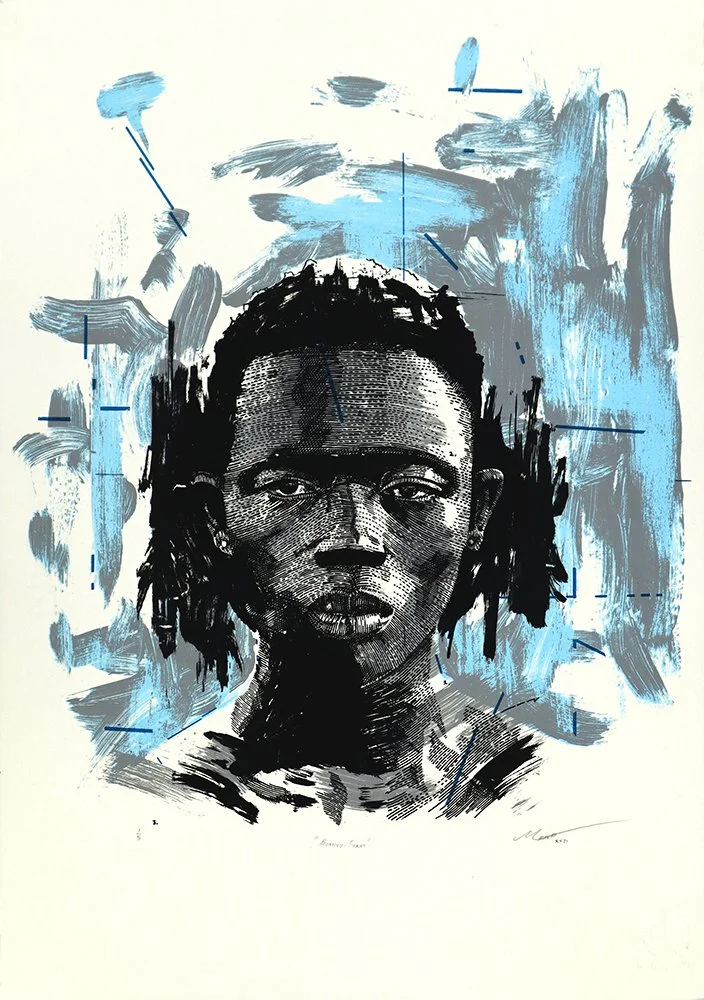

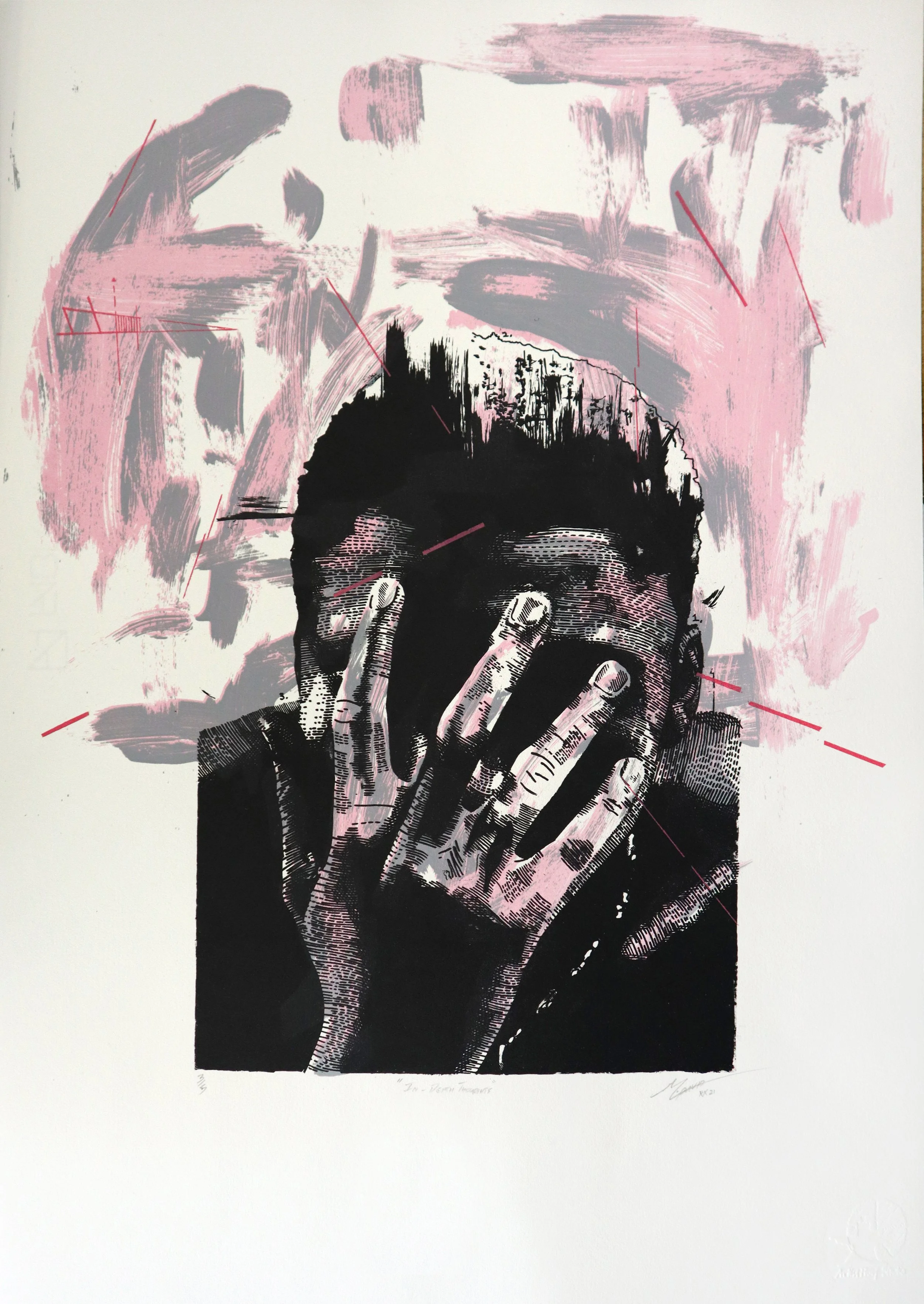






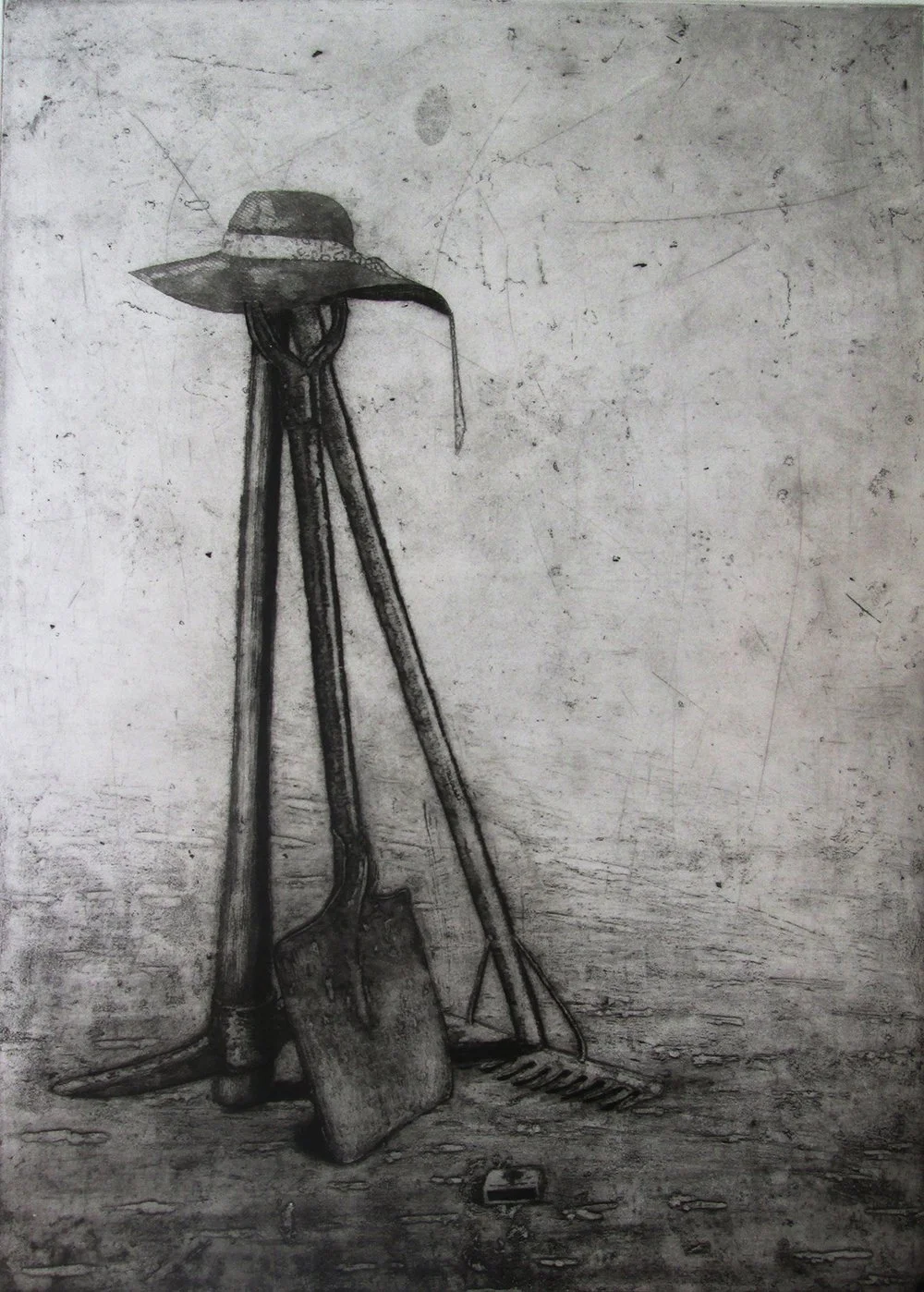






































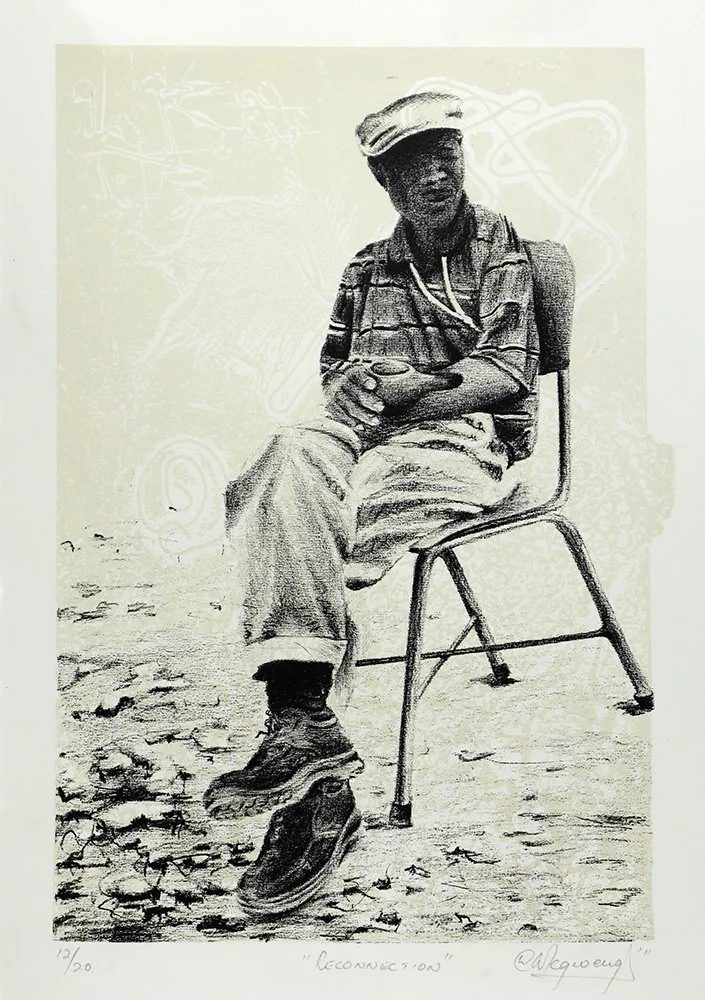

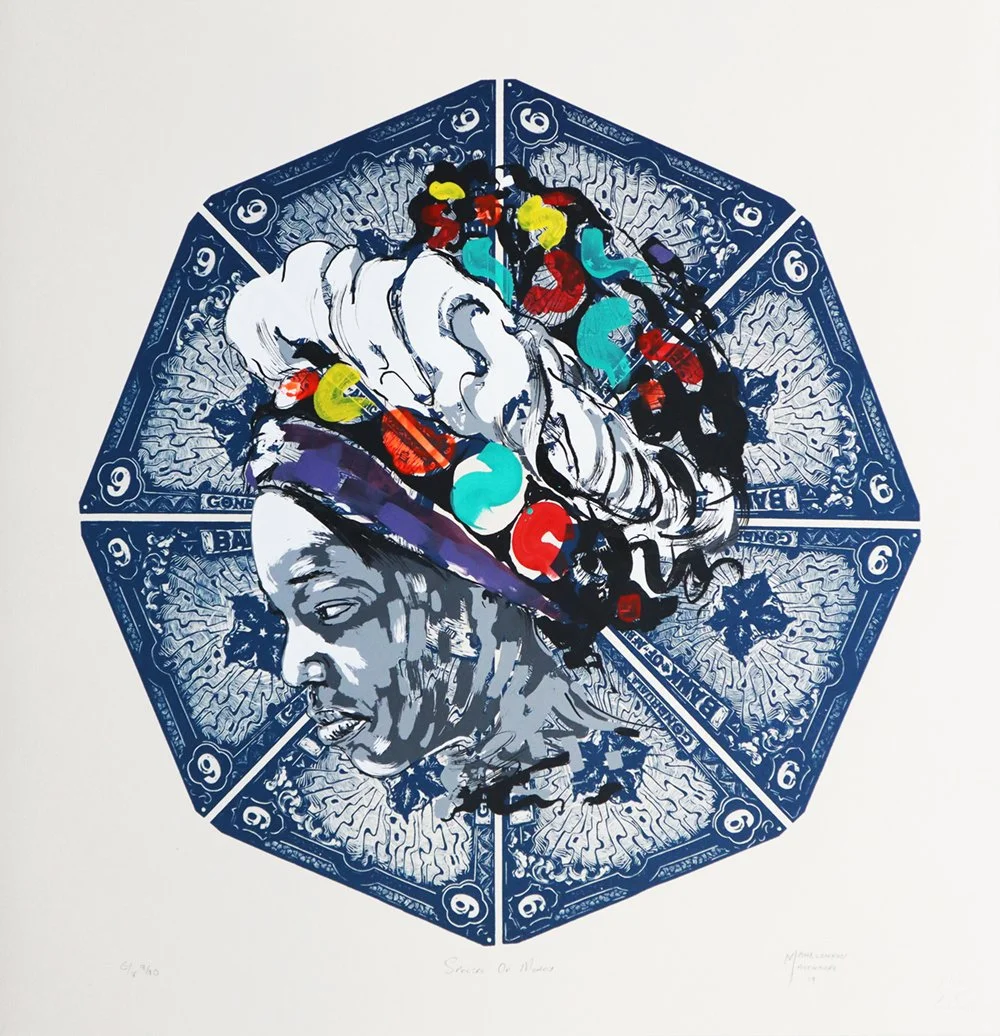



![Passage [14 years [v], 2023.jpg](https://images.squarespace-cdn.com/content/v1/59bfe9a7edaed8817767ed9f/1725644035932-3RXRY8DSE2UL6WY1I6I8/Passage+%5B14+years+%5Bv%5D%2C+2023.jpg)
![Passage [13years[iv], 2023 .jpg](https://images.squarespace-cdn.com/content/v1/59bfe9a7edaed8817767ed9f/1725644035060-MVTZWHYY5ZCZRK4PI6P3/Passage+%5B13years%5Biv%5D%2C+2023+.jpg)
![Sale [i], 2023 .jpg](https://images.squarespace-cdn.com/content/v1/59bfe9a7edaed8817767ed9f/1725644035994-YG94OF9M4BF9WTOSGYCE/Sale+%5Bi%5D%2C+2023+.jpg)
![Sale [ii], 2023 .jpg](https://images.squarespace-cdn.com/content/v1/59bfe9a7edaed8817767ed9f/1725644036868-DO0Z1ZE1PCRI3GT2ZUNY/Sale+%5Bii%5D%2C+2023+.jpg)
![Sale [iii], 2023 .jpg](https://images.squarespace-cdn.com/content/v1/59bfe9a7edaed8817767ed9f/1725644036957-5H3X5R8TQNT99ARK8W6W/Sale+%5Biii%5D%2C+2023+.jpg)
![Sale [iv], 2023 .jpg](https://images.squarespace-cdn.com/content/v1/59bfe9a7edaed8817767ed9f/1725644038019-9D1WAYD9OILBAHR997XW/Sale+%5Biv%5D%2C+2023+.jpg)
![Sale [ix], 2023 .JPG](https://images.squarespace-cdn.com/content/v1/59bfe9a7edaed8817767ed9f/1725644038067-FRAEX1GCOXDK4TA4VMFZ/Sale+%5Bix%5D%2C+2023+.JPG)
![Sale [v], 2023 .jpg](https://images.squarespace-cdn.com/content/v1/59bfe9a7edaed8817767ed9f/1725644039093-Z18YEFWQ4RSFM0UX0QZF/Sale+%5Bv%5D%2C+2023+.jpg)
![Sale [vi], 2023 .jpg](https://images.squarespace-cdn.com/content/v1/59bfe9a7edaed8817767ed9f/1725644039231-Y0NG5MEGPEGGMA68FIJ0/Sale+%5Bvi%5D%2C+2023+.jpg)
![Sale [vii], 2023 .jpg](https://images.squarespace-cdn.com/content/v1/59bfe9a7edaed8817767ed9f/1725644039986-EHFA9N3OPE78NMFUQNRU/Sale+%5Bvii%5D%2C+2023+.jpg)



